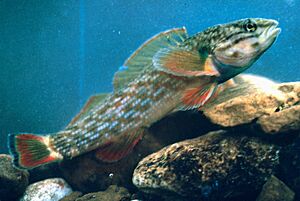Redline darter facts for kids
Quick facts for kids Redline darter |
|
|---|---|
 |
|
| Conservation status | |
| Scientific classification | |
| Synonyms | |
|
The redline darter (Etheostoma rufilineatum) is a small, colorful freshwater fish. It belongs to a group of fish called ray-finned fishes. This darter is part of the family Percidae, which also includes well-known fish like perches.
This special fish lives only in the southeastern United States. You can find it in the clear, rocky parts of streams, creeks, and small rivers. It prefers areas where the water flows quickly.
Redline darters are found in the Tennessee and Cumberland River systems. These rivers flow through states like Tennessee, Virginia, Kentucky, Alabama, North Carolina, Georgia, and Mississippi.
An average redline darter is about 6.9 centimeters (about 2.7 inches) long. The longest one ever found was 8.4 centimeters (about 3.3 inches). In the wild, these fish usually live for about four years.
Redline darters mostly eat tiny water bugs. Their diet includes larvae of midge flies, black flies, and caddisflies. They also munch on water mites and mayfly nymphs.
These fish lay their eggs in the spring and early summer, from May to August. The female lays her eggs, and the male fertilizes them. He then buries the eggs in the gravel at the bottom of the stream. After that, the male guards the nest until the eggs hatch.
The redline darter is quite common in many parts of its home range. This means it doesn't need special protection right now. However, keeping streams healthy helps them and many other fish species thrive.
Contents
Where Redline Darters Live
The redline darter acts like most other darter fish. It loves to live in the fast-flowing, rocky parts of small to medium-sized streams and rivers. You won't often find them in calm, deep pools.
These fish also like shallow areas with bedrock, especially if there are some scattered rocks or gravel. Bigger rocks are important because they offer safe spots to hide from predators.
Living in shallow water helps protect them from larger fish, like smallmouth bass. These bigger fish are often too large to swim into the fast, shallow parts of the stream. However, being in shallow water might make them easier targets for birds or raccoons.
What Redline Darters Eat
The redline darter's choice of home is also linked to its food. They eat larvae of water and land insects, plus other small invertebrates. This includes midge flies, black flies, caddisflies, and water mites.
These tiny creatures are usually found in large numbers in the areas where redline darters live. This means there's always plenty of food for them. What they eat can change depending on the season and where they are.
Because they eat similar foods and live in similar places, redline darters sometimes compete with other darter species for food and space. They also compete with other small fish that like the same kind of habitat.
Redline Darter Life Cycle and Reproduction
The breeding season for the redline darter starts in spring and goes into early summer. Fish living in higher, cooler places tend to breed a bit later than those in warmer, lower areas.
During this time, a female darter will lay between 21 and 131 eggs. She carefully places them directly into the gravel at the bottom of the stream. This helps keep the eggs safe from animals that might want to eat them.
After the eggs are laid, the male darter fertilizes them. He then stays to guard the nest until the eggs hatch. This protection helps the young darters survive.
Redline darters are thought to live for about four years in the wild. They can start having babies after they are one year old. This means a female might lay around 350 to 400 eggs in her whole life. This number is quite low compared to some other fish that lay thousands of eggs.
However, redline darter eggs and young fish have a good chance of surviving. This is because the eggs are hidden, and the male fish protects them.
One big problem for darter eggs is siltation. This happens when dirt and mud wash into the water, either from human activities or natural events. Too much silt can stop oxygen from reaching the eggs, which can prevent them from hatching.
Protecting Redline Darters
Right now, there are no special programs just for the redline darter. This species is not considered endangered or threatened. In fact, it's one of the most common darter species, with possibly over a million individuals.
Many government groups, like the US Fish and Wildlife Service and the National Park Service, watch over streams. They work to make streams healthier and count fish populations. While they don't focus only on redline darters, they collect information about them. This helps make sure future problems are avoided.
Also, many states are working to stop pollution and siltation. They pass laws and teach landowners how to prevent dirt and mud from washing into streams. When water gets cloudy from silt and pollution, it's hard for darters to find food, breed, and even escape from predators. Keeping water clear is very important for these fish.


